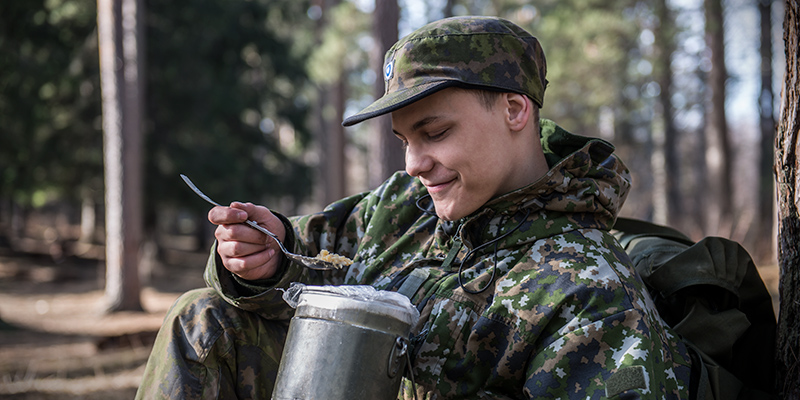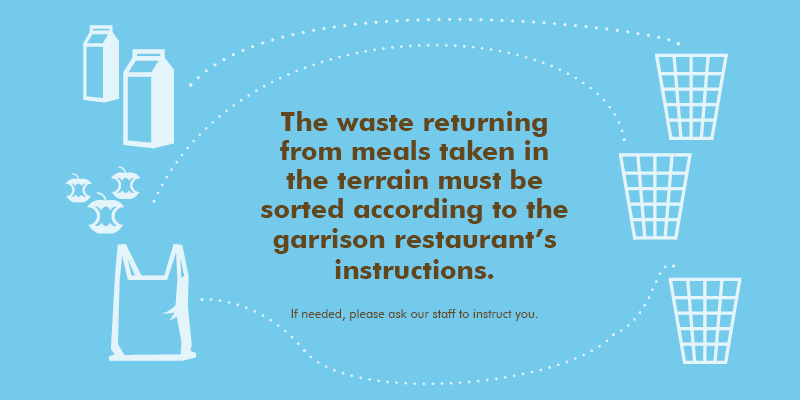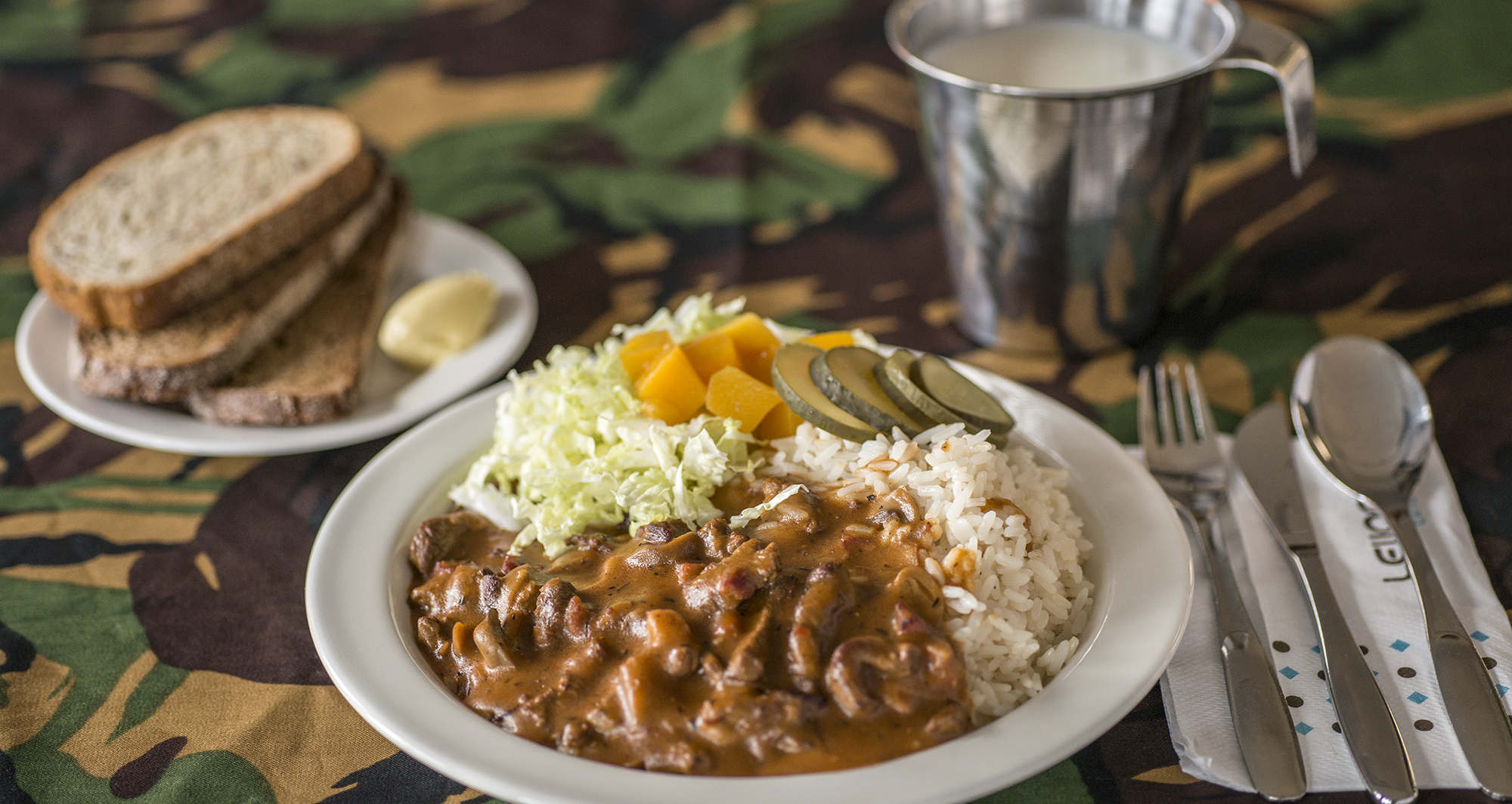Tasty meals on a daily basis
Our garrison kitchens combine ironclad expertise with constant learning. We prepare tasty and healthy meals using clean and carefully selected ingredients. For us, healthy and delicious food is a matter of the heart, and for good reason: we have had the honour of keeping the Finnish army fed since 1918. We wish to take good care of all of our soldiers – our boys and girls – and ensure that they have enough energy to serve their country each and every day.
As in everyday life, in military service a balanced meal still consists of protein (meat, fish, chicken or vegetable protein) and carbohydrates (potato, pasta, rice, etc.) complemented by bread and fruits and vegetables.
Each soldier can ensure adequate energy intake by taking every offered meal and eating all parts of each meal.
The cooks and staff of garrison restaurants help conscripts by providing them with delicious food throughout their service period!

Breakfast, lunch, dinner and evening meal
A soldier’s day begins with a breakfast built around a highly fibrous porridge. In addition to the porridge, the offering contains bread, spreads and cold cuts. The drink choices are non-fat milk, juice or water. The warm drink options are coffee, tea and hot chocolate.
At the garrison restaurant, the main courses of lunch and dinner are traditional home-made dishes. These are complemented by two salad options and a dessert at lunch.
Yes, we still serve pea soup and
pancakes on Thursdays.
When taken in the field, the main courses of lunches and dinners are usually casseroles or soups that are easy to eat with the mess kit. Each meal is always complemented with vegetables and/or fruit. Dessert is offered either at lunch or at dinner, depending on the situation. Mobile meals such as field rations and lunch bags are designed to ensure adequate energy intake in various situations – even when heating food is not possible because the troop is in transit.
Evening meals may be taken either in garrison restaurants or they can be packed in with dinner when in field conditions. The contents of the evening meal vary depending on the circumstances.
The menu of garrison restaurants changes every six weeks. Read more about the different meals offered during military service.

Special diets
We take special diets into account in all of our meals, whether they are enjoyed in a garrison restaurant or out in the field. Today, various diets are already factored in at the development stage of our food products.
We have already asked you about your dietary preferences before you entered into service. If your diet has changed since that preliminary questionnaire, or if you have never responded to it, please contact your squad leader as soon as possible after entering service.
Come on! Come on!
Our menu is centrally designed to meet the needs of our soldiers. All of our menus are based on the nutritional recommendations issued by the state’s advisory board on nutrition. The menus of our restaurants may be viewed on the menus page.
The energy and protein needs of a soldier are affected by their age, sex, weight and level of athletic activity. We base the energy content and composition of our day-specific menus on the PAL value*. The highest defined PAL value in the nutritional recommendations is 1.8, denoting an energy content that is 1.8 times higher than what basic metabolism consumes.
| | |||
| Nutrient | Recommendation (18-30 -y/o men, PAL* 1.8) | Menu of the garrison restaurant | |
| Energy | 3200 kcal | 3500-3600 kcal | |
| Protein | 15 % | 17 % (151 g) | |
| Carbohydrate | 52 % | 52 % | |
| Fats | 32-33 % | 30 % | |
| Saturated fats | Alle 10 % | 8 % | |
| Fibre | 25-35 g | 46 g | |
| |
*The PAL value, or Physical Activity Level value, is a value depicting an individual’s total energy consumption in relation to basic metabolism.
The share of protein as an energy source in nutrition should be 15 % on average. For active 18-30-year-old men, the nutritional recommendations suggest 1.1 – 1.3 g of protein / kilo of body weight / day. Leijona Catering’s menus are designed to contain 1.5 – 2 g of protein / kilo of body weight / day. A day’s meals contain a total of 151 g of protein on average. This is certainly enough energy for regular military service.
Carbohydrates act as the body’s fuel and thus they preserve protein for other important tasks, such as muscle maintenance. Some 52 % of daily energy intake should come in the form of carbohydrates.
If you are an active athlete in your spare time, please ensure that you receive enough additional energy each day.

The Heart Symbol – good for you
Our garrison restaurants regularly offer dishes that meet the Heart Symbol criteria. They are marked on the menu with the abbreviation SY (for Sydänmerkki, Heart Symbol). If a recipe is to receive the Heart Symbol, it needs to pay attention to the amount of salt and the amount and quality of the included fats. The amount of fibre is crucial in grain-based meal parts, such as bread and energy supplements. With these slight changes we aim to reduce the harms of excess salt and hard, saturated fat.
Take what you eat, eat what you take
Only take so much food that you think you need or know that you can eat.
Example:
If each soldier throws 15 g of uneaten food (= one meat ball) into the biowaste per meal, in a year that comes to 285 000 kilograms – a whole 9 truckloads of wasted food.
We at Leijona Catering strive to reduce food loss and waste in our operations:
- by preparing tasty dishes
- using ingredients carefully
- by making the right amount of food as per the FDF’s order
- by anticipating when the soldiers will be taking their meals and phasing the food preparation accordingly.
Food ending up as waste is waste many times over: it wastes raw materials, energy, and work. However, if there is leftover food on your plate or in the thermal containers, sort the waste according to the garrison restaurant’s instructions.
Please ensure that your food waste is sorted according to the garrison restaurant’s instructions – even in the terrain.

Types of waste should not be mixed together but they should all be sorted into their own waste containers. Dishes and thermal containers used to deliver the food do not belong among the garbage.






